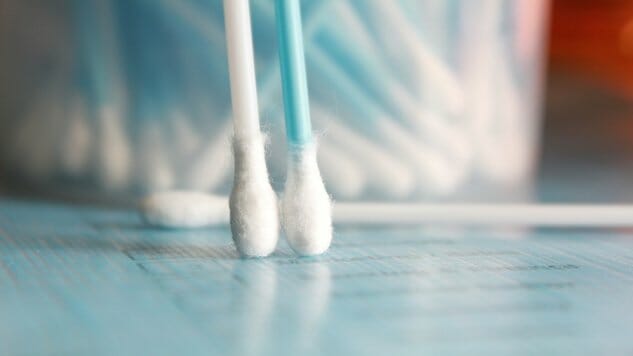
Note: This article is not meant to diagnose medical conditions. For medical expertise, readers should consult their physician. The author is not a licensed medical professional.
![]()
Cotton swabs, paper clips, fingernails, ballpoint pens, toothpicks and bobby pins. This isn’t a shopping list for amateur lock-pickers—they’re all objects people have stuffed in their ears in a misguided attempt to clean out their earwax.
People have a common misconception that earwax is a sign of dirty ears. Contrary to popular belief, it’s one of the good guys. Similar to the protective qualities of your boogers, earwax is a sticky agent that acts as a lubricant and prevents water, dust, small particles, and insects from sneaking into the ear. It even contains antimicrobial peptides that prevent bacteria and fungi from invading the auditory canal and causing infection. Humans aren’t the only mammals equipped with this defense system—take a look inside your cat’s ears and you’ll discover the same liquid gold inside.
The glands in the ear continuously make new earwax and push out the old during a natural self-cleaning process. Old earwax migrates to the ear opening during chewing and jaw movement, and then flakes off during bathing.
Inserting objects like cotton swabs into the ear can actually push the wax further in, damage the ear drum, and cause earwax impaction. Impaction occurs when an excessive buildup of earwax blocks the ear canal. While generally harmless, it can cause a host of uncomfortable symptoms, including pain, itching, ringing in the ear, hearing loss, discharge, and odor.
An estimated 12 million people in the United States seek medical care for problematic earwax per year, resulting in nearly 8 million removal procedures. In an effort to debunk the myths surrounding earwax and prevent impaction, the American Academy of Otolaryngology-Head and Neck Surgery Foundation recently published an updated clinical practice guideline on the treatment of earwax.
“There is an inclination for people to want to clean their ears because they believe earwax is an indication of uncleanliness. This misinformation leads to unsafe ear health habits,” said Dr. Seth R. Schwartz, chair of the guideline update group, in a press release.
Here are some evidence-based tips for keeping ears healthy while avoiding practices that damage the ears.
What Shouldn’t You Do?
• Don’t put anything smaller than your elbow in your ear. Seriously. Inserting objects into the ear only irritates them, and can actually lead to the production of more earwax.
• Don’t be fooled by appearances. Your cotton swab might look like an earwax crime scene, but in reality you’re probably only packing it further into the ear canal. You might even cause injury or permanent damage by putting a hole through the eardrum, or scratching the skin.
• Don’t use ear candling, also known as ear coning or thermo-auricular therapy. This alternative therapy involves lighting a hollow candle, and placing the unlit end in the ear canal. Practitioners allege that candling drains earwax and toxins from the ear, but there is no evidence that this is effective. In fact, it can burn the ear canal, cause infection, and even hearing loss.
• Don’t use daily olive oil drops or sprays. These are common home remedies, but the clinical practice guideline advises against them.
What Should You Do?
• Imagine there are lots of microscopic maids in your ear mopping up the mess. In other words: leave your ears alone, and let the natural self-cleaning process do its thing. The only time you should worry about your earwax is if you’re experiencing uncomfortable symptoms.
• Recognize the symptoms of earwax impaction—itching, discharge, hearing loss, odor, ringing, cough, and feeling of fullness in the ear—and see your doctor if you experience them. These symptoms may also be indicative of other medical conditions that require attention, so don’t put it off.
• Earwax impaction is more common in elderly people, and people who use hearing aids or earplugs. Hearing aids should be regularly cleaned according to manufacturer and doctor recommendations.
What If You Have Impaction?
• Make your ENT your BFF. The most important thing is to see the doc. Once they’ve examined your ears, you can discuss a number of options.
• Your doc might decide the best course of action is to wait it out and observe. Your body might just resolve the problem on its own without requiring further maintenance.
• Irrigation systems are another popular option that clean the ear canal with a stream of warm water. This method is generally safe and effective, but is not recommended for people who get lots of ear infections or have other ear conditions. Again, consult the doc before using one.
• Certain ear drops—cerumenolytics—can be administered over a few days to soften the earwax so it can be more easily removed. This can also be used in conjunction with an irrigation system.
• Health providers can use other special instruments—ear curettes, probes, hooks, forceps, or microsuction—to remove earwax at the office. This carries some risk of scratching the ear canal, and should only be done by a health professional.
Image: PDPics, CC-BY
Gulnaz Khan is a D.C.-based writer seeking to uncover the mysteries of the human body. Find her on Twitter and Instagram.